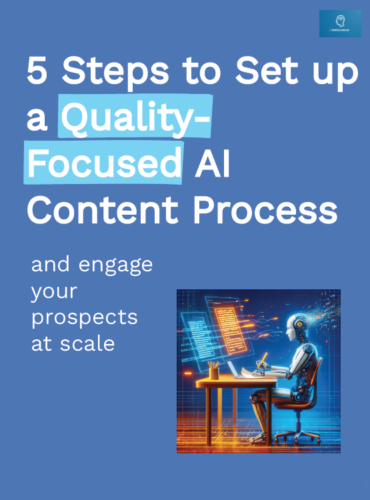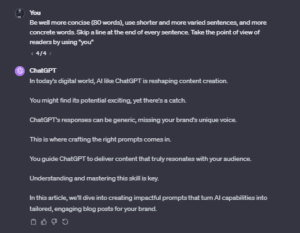“In the realm of content marketing, AI is a game-changer for marketers, serving as a magic wand to fast content creation“
Ever cringe at content like this? You’re not alone. Oftentimes, AI-generated content sounds too much like AI to be interesting and trusted.
You better refine and edit the output to deliver high-quality pieces to your audience.
I spent much time looking for the best process to create content that sounds human and is yet fast-produced by AI. Here are my recommendations.
Why add a human touch to your AI content?
However skilled LLMs are at writing, they can still fall on repetitive and robotic patterns. So much so that it’s quite easy to identify the particular style of AI-generated content (especially at zero-shot learning).
This is not necessarily for the good of the readers. It comes with unnecessary redundancy, hallucinations, dubious analogies, and inaccuracies.
Humanizing your content means manual editing and refining that will make your content more helpful, accurate, and engaging.
It helps you :
- Comply with Google E-E-A-T guidelines and thus make your content rank high on SEO results.
- Make your content more appealing and relatable to your audience.
- Make it sound unique, with a tone and style that reflects your writing voice or your brand identity. And also avoid PR backlash if people react strongly to blatant AI-generated content.
What makes content sound “human” vs “AI-generated”?
Despite diminishing differences, there are still unmissable distinctions between human-written and AI-generated content.
The “default” style of LLMs (without sophisticated prompting and human editing) can be identified by some key characteristics. Conversely, some things make human-like content so engaging and relatable.
Here’s a breakdown of their differences :
| Human writing | AI writing |
| Use of first-person and second-person pronouns | Use of passive and undetermined voice |
| Bringing fresh ideas and insights on the topic | Generic, unoriginal, abstract information. |
| Concrete, down-to-heart and helpful | Metaphoric and generic |
| Personal and relatable | Unspecific and overwhelming |
| Straightforward and synthetic reasoning | Repetitive and redundant thinking |
| Varied and unpredictable writing patterns | Predictable and regular writing structures (same-length paragraphs, equal numbers of sections,…) |
6 steps to humanize your AI content
I’ve spent countless hours refining and editing poor AI outputs. Here are some of my best practices that you can follow to make your content human-like, fresh, and highly relatable :
1. Provide a draft of original ideas to the AI

LLMs rely on a publicly available knowledge base. Do you want to deliver ideas that most people already know? Hard to agree.
That’s why you must bring first-hand, experiential knowledge to your AI. Put all your lessons learned, subject matter expertise, study and interview material on paper, and provide that draft to the AI.
You can use a prompt like this :
“Give me an outline about *your subject* based on this first draft of ideas : *your draft* “
2. Teach it a unique style and tone

Why settle on the default style of your LLM? GPT-4 can be customized at will, as long as you instruct them with the right prompts.
You might first provide your AI with specific editorial guidelines that reflect your brand or voice. You can use a prompt like this :
“Each time you’re writing something, follow this step-by-step guideline :
- Adopt an engaging, helpful voice, providing actionable and concrete insights, and avoiding buzzwords.
- Use concise, short and easy-to-understand sentences.
- In your writing, put your readers’ goals and concerns first by adding pronouns like “you” or “your”.
Reply “ok” if that’s clear for you.”
It’s important to note that ChatGPT might not remember and rigorously apply your guidelines because of its limited context window (which is another way of naming LLM’s attention). You have to give it a writing sample to make it understand what you’re expecting in terms of tone and style.
You might use the following prompt for that :
Here’s a writing sample to help you determine what kind of writing style and tone we expect. Only reply “ok” if the extract is clear for you. Here’s the extract :
3. Remove the “bullshit” words

LLMs are trained to output predictable writing structures and formulations. This explains why it loves to express excessive optimism with inflated words. Let’s say that it comes from the millions of marketing content out there overselling their products.
These overhyped don’t sound professional and authoritative. So you might better get rid of common “bullshit words” like :
- “In the realm of “ “In the world of” In an era where” “In a time of”
- “Revolution”, “latest innovation”, “transforming” “game-changer” “breakthrough”, “fast-paced”
- “Unprecedented”, “unparalleled” “magic”
- “unleash”, “unravel”, “harness”, “unlock”
4. Add more variety to AI formatting
Another clear sign of AI content is a very predictable and repetitive writing structure. LLMs tend to follow the same patterns in terms of sentence length, paragraph structure, and formatting. They have a hard time breaking their own thought patterns.
It’s your job as a human editor to add more variety and life to your text by :
- Removing repetitive introduction and conclusion sections that don’t add anything new for the readers
- Alternating between bullet points and subsections to add more variety to the eye
- Remove some sentences there, add some others there to add more unpredictability to the flow of reading
5. Watch out for metaphors and citations

Even more apparent is LLMs’ passion for metaphors and comparisons. Their writing often includes formulations such as “imagine” “just as” “are like” “it’s like”. You will need to check your text for these frequent metaphoric occurrences and assess their relevance. Some might be interesting, but most of them are just too much, especially if you ask ChatGPT to have a more “casual” style.
You might also look for hallucinations. When it comes to sourcing an authority on a subject, AIs tend to invent from scratch people and citations. So better to fast-check every outside reference that AIs do to back its claims.
6. Enhance with illustrations and examples
Nothing better than illustrations and examples to make your ideas more concrete in your reader’s mind. But AIs won’t necessarily provide you with some by default. You’ll have to find them yourself, or ask ChatGPT to brainstorm. This will help you level up your content and claim the status of “thought leadership”.
Here are some nice additions to your content :
- Relevant stats and infographics from your research.
- Citations from experts or relevant authorities.
- Testimonials, case studies that you collected.
- Step-by-step action plan and best practices that you followed yourself.
- Examples and templates of emails, presentations, spreadsheets, and other materials.
The best AI humanizer tools

Let’s start by saying that AI humanizer tools are helpful but can’t replace the critical role of human editing. These tools make your content sound more natural and help it pass AI detection, but they don’t add new ideas or insights. That’s where you come in. Your unique perspective and creativity are what truly enrich content.
Human editing also involves evaluating the relevance of your content, ensuring it aligns with your audience’s interests, and making decisions about structure and flow that AI can’t. While AI suggests changes based on data, it lacks an understanding of human emotions and the specific preferences of your audience.
Now, if you want to leverage some of these tools, here are the most interesting ones :
- Humbot is your go-to for quick, user-friendly content humanization. It’s designed to work fast, ensuring your text remains original and engaging without falling foul of AI detectors. Its pricing is competitive, starting at a low entry point, which means you can enhance your content without breaking the bank.
- Bypass AI excels in transforming AI text into natural-sounding content with a single click. This tool not only improves the readability of your content but also has features that could boost your SEO. It supports a broad range of content types and offers an interesting affiliate program, potentially opening up another revenue stream for you.
- Stealth Writer uses advanced natural language processing techniques to infuse your content with emotion and personality, making it more relatable and engaging. Besides enhancing your text, it also focuses on SEO and conversions, helping your content perform better in search engines.
- Undetectable AI is unique in offering a built-in AI detector, which means you can immediately check the likelihood of your content being flagged as AI-generated. This dual functionality can save you time and money, eliminating the need for separate AI checking tools.
- Lastly, AISEO is known for its extensive features designed to remove AI detection from your content. If you’re looking for a tool that offers a wide range of capabilities to ensure your content remains both engaging and original, AISEO might be worth considering.
Ready to make your AI content sound like no one else? Trust the process and follow the previous guidelines!





